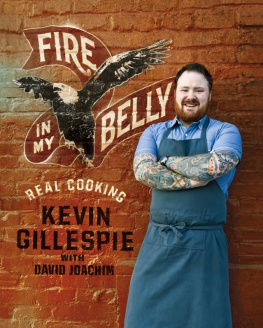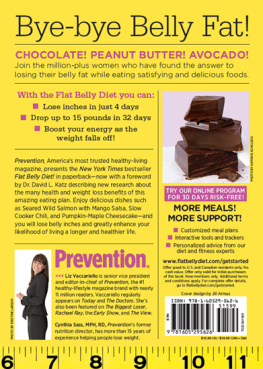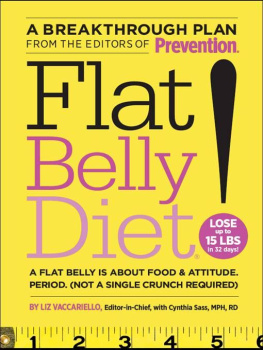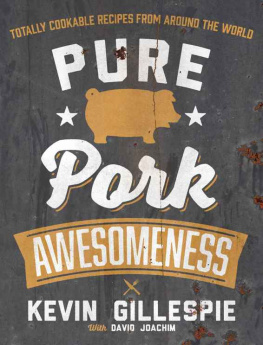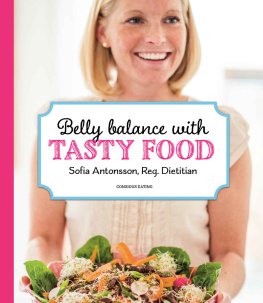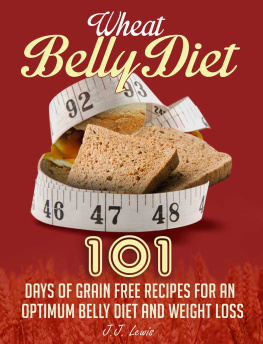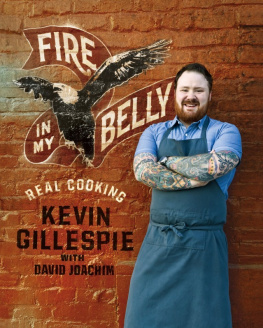Fire in My Belly text copyright 2012 by Kevin Gillespie. Photography copyright 2012 by Angie Mosier. All rights reserved. No part of this book may be used or reproduced in any manner whatsoever without written permission except in the case of reprints in the context of reviews.
Andrews McMeel Publishing, LLC
an Andrews McMeel Universal company
1130 Walnut Street, Kansas City, Missouri 64106
www.andrewsmcmeel.com
ISBN: 978-1-4494-2642-2
Library of Congress Control Number: 2012936726
www.chefkevingillespie.com
Photography: Angie Mosier
Design: Rodrigo Corral Design
ATTENTION: SCHOOLS AND BUSINESSES
Andrews McMeel books are available at quantity discounts with bulk purchase for educational, business, or sales promotional use. For information, please e-mail the Andrews McMeel Publishing Special Sales Department:
CONTENTS
CHAPTER
WHAT I MEAN WHEN I SAY...
A couple years ago at Woodfire Grill, we were serving a carrot dish that was made at the cold station in the restaurant kitchen. At that time, a cook named John was at the station, and he was responsible for making the dish. It was an exploration of carrot with four different components: a cold carrot broth, a carrot gele, baby carrots, and a carrot sauce. This was a technical dish that was difficult to execute. The components needed to be served on the same plate but at slightly different temperatures so the flavors would come across properly. This was right after Top Chef Season 6 had aired, so the restaurant was getting busy, and I was fielding a lot of calls. I quickly summed up for John why he needed to constantly move the sauce from the oven to the cold station to maintain the correct temperature of the sauce. I remember saying, It needs to be just above below room temperature. Thats a crazy-ass way of putting it, but the phrase made perfect sense to me.
It was getting colder in the kitchen because winter was coming on, and even with the burners and fryers cranked up, the room temperature was somewhat cold. Below room temperature would have been too cold, but at just a few degrees higher than below room temperature, the sauce was perfect. After hearing me speak that phrase, John looked at me like I had three heads. I was too busy to explain it further. I walked away to let him figure it out.
Throughout my career, one thing thats made me successful is my ability to clearly communicate. I have, however, come to the realization that some phrases I think are perfectly clear may not be so clear to others. I have a million thoughts running through my head, and sometimes when I speak, Im only saying the twelfth sentence of what was actually a complete articulated thought in my head. But sentences one through eleven, the ones that really help to explain what I mean, never get spoken. As a result, Ive become known for a kind of shorthand Kevin-speak in the kitchen.
My chef de cuisine, E.J. Hodgkinson, has gotten pretty good at understanding Kevin-speak and reading my mind. But I realize that the terminology I use may not be familiar to everyone. Heres a thorough explanation of what I mean when I say things like balance, buried, cut like a whole vegetable, GBD, pitch, plucky, and washing machine method. I organized this glossary of Kevin-speak alphabetically by Ingredients, Techniques, and Equipment, so you can easily find out just what the hell Im trying to say in the recipes.

Ingredients
Black pepper: I always grind it fresh. Like any other spice, black pepper starts to lose its aroma as soon as you grind, crack, or crush it. Fill a pepper grinder with Tellicherry peppercorns and keep it on your kitchen counter. A single grind usually measures out to a pinch, and 6 grinds should be about teaspoon.
Browned butter: One of my favorite flavors with fish and vegetables. I give instructions for making it with the recipes, but you owe it to yourself to make this on a whim. Its dead easy. Heat a heavy skillet over medium heat; add some butter and let it melt and foam up. When the foam fades, the milk solids will sink to the bottom of the pan and start to turn brown. Give the butter a stir so it browns evenly. The color will go from light brown (beurre noisette) to dark brown (beurre noir) and the aroma will become increasingly intense and nutty. To cool it quickly so the milk solids dont burn, I pull the pan from the heat and dip the bottom of it into a big bowl of ice water.
Butter: Unsalted, always. The fresher the better, but regular grocery store butter will do.
Clarified butter: Another kitchen staple. You strain out the milk solids from melted butter so that the butter can withstand higher temperatures for sauting and such. Its made like browned butter but without the browning. Put a pound of butter in a small heavy-bottomed saucepan and melt it over medium heat. The milk solids will drop to the bottom of the pan and the liquid on top will look clear. Pull the pan from the heat and skim off any foam and water from the top. Strain the butter through a fine-mesh strainer lined with cheesecloth or a clean coffee filter, leaving the milk solids behind in the pan. You should be left with only golden, clarified butter. Pour it into a container, cover, and refrigerate for up to 2 months. Use it whenever youre cooking with high heat. Ghee is clarified butter thats allowed to brown and is then strained to remove the browned milk solids. It has an even higher smoke point than clarified butter.

Espelette pepper: This is my go-to mild ground red chile pepper. Its a little hotter than paprika, a little milder than cayenne, and more aromatic than both. Espelette comes from the Basque region of France, and the genuine article tastes best. You want to buy authentic piment dEspelette that carries an AOC (Appellation dOrigine Contrle) label, which guarantees that the product actually comes from the town of Espelette in France. Upscale spice sections will carry Espelette pepper, or you can find it online (see ).
Lemons and limes: I always call for whole fresh citrus in the recipes, so you can zest it or squeeze it on the spot. Dont use the lemon or lime juice stored in those citrus-shaped plastic bottles. Its crap. Lemons and limes keep in the fridge for at least 2 weeks, and you should be using them all up in that time anyway. Plus, theyre cheap.
On a shopping spree at Morningside Farmers Market.
Oil: When Im sauting or cooking with high heat, I use grapeseed oil. It has a high smoke point (about 445F) and a clean, mild flavor. But I probably use more olive oil than anything else. My day-to-day olive oil for cooking is made in Chile from Arbequina olives (see ).
Panko dust: Japanese panko bread crumbs produce a lighter, crispier crust on breaded foods. For an even crispier crust, I like to grind the panko to dust in a food processor, then shake it through a sieve to filter out any large pieces.

